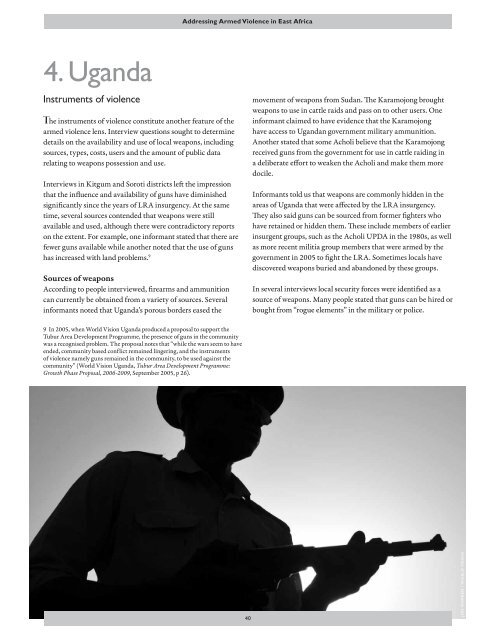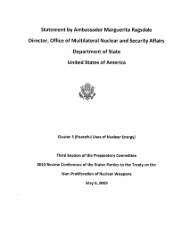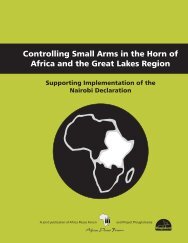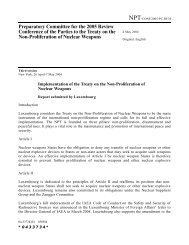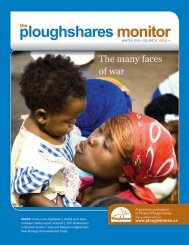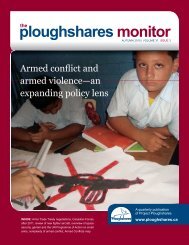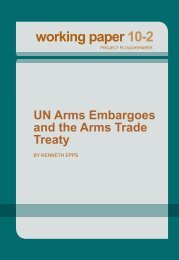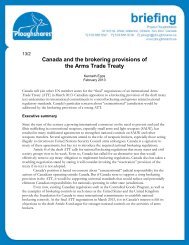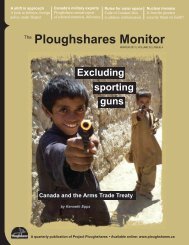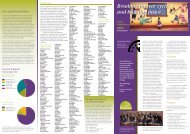Addressing Armed Violence in East Africa.pdf - Project Ploughshares
Addressing Armed Violence in East Africa.pdf - Project Ploughshares
Addressing Armed Violence in East Africa.pdf - Project Ploughshares
Create successful ePaper yourself
Turn your PDF publications into a flip-book with our unique Google optimized e-Paper software.
<strong>Address<strong>in</strong>g</strong> <strong>Armed</strong> <strong>Violence</strong> <strong>in</strong> <strong>East</strong> <strong>Africa</strong>4. UgandaInstruments of violenceThe <strong>in</strong>struments of violence constitute another feature of thearmed violence lens. Interview questions sought to determ<strong>in</strong>edetails on the availability and use of local weapons, <strong>in</strong>clud<strong>in</strong>gsources, types, costs, users and the amount of public datarelat<strong>in</strong>g to weapons possession and use.Interviews <strong>in</strong> Kitgum and Soroti districts left the impressionthat the <strong>in</strong>fluence and availability of guns have dim<strong>in</strong>ishedsignificantly s<strong>in</strong>ce the years of LRA <strong>in</strong>surgency. At the sametime, several sources contended that weapons were stillavailable and used, although there were contradictory reportson the extent. For example, one <strong>in</strong>formant stated that there arefewer guns available while another noted that the use of gunshas <strong>in</strong>creased with land problems. 9Sources of weaponsAccord<strong>in</strong>g to people <strong>in</strong>terviewed, firearms and ammunitioncan currently be obta<strong>in</strong>ed from a variety of sources. Several<strong>in</strong>formants noted that Uganda’s porous borders eased themovement of weapons from Sudan. The Karamojong broughtweapons to use <strong>in</strong> cattle raids and pass on to other users. One<strong>in</strong>formant claimed to have evidence that the Karamojonghave access to Ugandan government military ammunition.Another stated that some Acholi believe that the Karamojongreceived guns from the government for use <strong>in</strong> cattle raid<strong>in</strong>g <strong>in</strong>a deliberate effort to weaken the Acholi and make them moredocile.Informants told us that weapons are commonly hidden <strong>in</strong> theareas of Uganda that were affected by the LRA <strong>in</strong>surgency.They also said guns can be sourced from former fighters whohave reta<strong>in</strong>ed or hidden them. These <strong>in</strong>clude members of earlier<strong>in</strong>surgent groups, such as the Acholi UPDA <strong>in</strong> the 1980s, as wellas more recent militia group members that were armed by thegovernment <strong>in</strong> 2005 to fight the LRA. Sometimes locals havediscovered weapons buried and abandoned by these groups.In several <strong>in</strong>terviews local security forces were identified as asource of weapons. Many people stated that guns can be hired orbought from “rogue elements” <strong>in</strong> the military or police.9 In 2005, when World Vision Uganda produced a proposal to support theTubur Area Development Programme, the presence of guns <strong>in</strong> the communitywas a recognised problem. The proposal notes that “while the wars seem to haveended, community based conflict rema<strong>in</strong>ed l<strong>in</strong>ger<strong>in</strong>g, and the <strong>in</strong>strumentsof violence namely guns rema<strong>in</strong>ed <strong>in</strong> the community, to be used aga<strong>in</strong>st thecommunity” (World Vision Uganda, Tubur Area Development Programme:Growth Phase Proposal, 2006-2009, September 2005, p 26).40JON WARREN / World Vision


